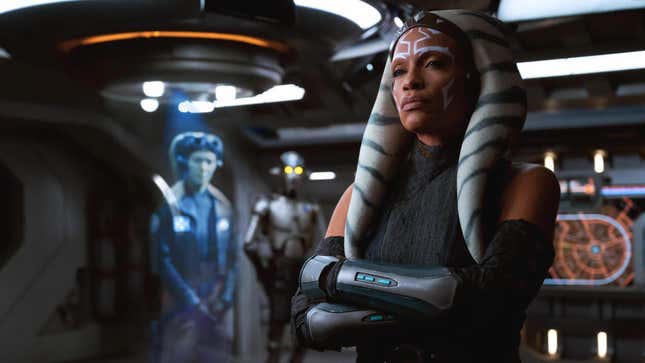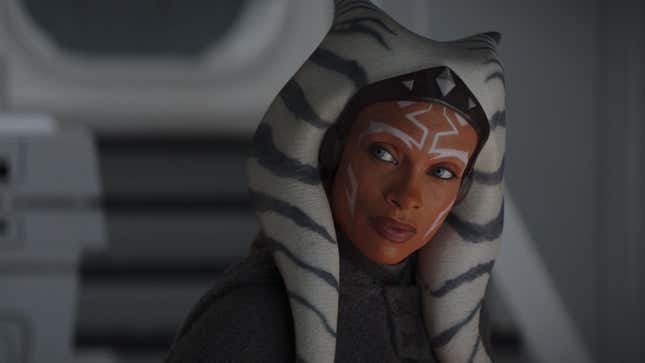Ever since Ahsoka Tano stepped out of the mists of Corvus and into live-action Star Wars history on The Mandalorian, I’ve had complicated feelings about the direction of one of my favorite Star Wars characters in contemporary canon. Those feelings haven’t changed much in the opening episodes of her new titular series so far—but watching them this past week I found one thing giving me a tiny glimmer of the Ahsoka I remember: the feelings stirred by the show’s end credits.
Why is the Dancing Baby an NFT?
That’s not a particular dig at Ahsoka itself—I’m not relieved when an episode is over, by any means. Its first two episodes are perfectly fine set up, and somewhat ironically at their best at the moments where the focus is placed on characters like Rebels’ Sabine Wren and Hera Syndulla rather than Ahsoka herself. The series crackles with a potential energy when exploring Sabine’s feelings about her past connection to Ahsoka and the Rebels crew, or in the fun of watching Hera and her droid Chopper banter and fly cool ships like we’re just right back into telling Rebels’ story all over again.

That energy, however, almost vanishes when Ahsoka herself is on screen. She feels like a detached observer in what is ostensibly her own series, given a perspective in dialogue and in the lens of the direction itself that makes it feel like Ahsoka is far less interested in Ahsoka Tano than it is pretty much anyone else in her orbit, as she drifts from scene to scene with little more than a display of Rosario Dawson folding her arms across her chest, ready to intently observe the narrative unfolding before her rather than really participate in it.
And that’s just kind of been Ahsoka’s vibe ever since she came to Star Wars live action. In “The Jedi,” her debut in The Mandalorian, she feels like something of an aimless drifter, chasing leads here and there but also distinctly put off by the idea of getting involved when an opportunity—in that case, the training of the young Grogu as a Jedi— is put in front of her. Likewise when she returns in The Book of Boba Fett, she’s there to fade into the moment, acknowledge that she’s part of it as she watches Luke Skywalker—the son of the master she left behind and ultimately tried to fight to the death after his horrifying transformation into Darth Vader—train Grogu and start to rebuild the Jedi Order that once abandoned her, and then fade back into the background, intent on staying uninvolved.

This in and of itself is not entirely a complaint either. As I alluded to, there’s a lot of potential in exploring this idea of Ahsoka, one of the most important people metatextually to modern Star Wars, almost outright rejecting that importance in the story itself. She tried being the hero the galaxy wanted her to be in her past lives: a Jedi leader in the Clone Wars until the Council hung her out to dry, leading to her parting ways with the Order. A citizen of the Republic, until it too turned on her through Palpatine’s machinations. An agent of Rebellion, until past traumas saw her cut off from it in turn after her duel with Vader on Malachor. What does Ahsoka Tano owe this galaxy that’s caused her so much hurt over her life, to be its hero—to be the one that has to now stop Grand Admiral Thrawn as the ascendant Heir to the Empire?
The problem is that none of her live-action appearances so far have really engaged with that idea—Ahsoka has been left to be portrayed as distant and uninvolved but not really explored as to why she is like that, at least so far. It’s frustrating, but also something I’m not quite willing to levy against Ahsoka as a show just yet. After all, there’s another six episodes for it to actually treat its titular character with the same kind of dramaturgical interest it holds for Sabine and Hera. But I’m also not yet willing to levy it against Ahsoka for that peculiar thing I mentioned earlier: the feeling sparked in me by Ahsoka’s end credits music.
Kevin Kiner has been a part of Ahsoka’s Star Wars life since the very beginning, having composed music for Clone Wars and Rebels—including the 14-note leitmotif that has followed her from that first movie 15 years ago all the way to this end credits sequence—and now Ahsoka, and that understanding of her long journey, feels thematically resonant to the four-minute orchestration that plays over the series’ ending titles. And while part of my frustration with Ahsoka’s live-action arc has been leaving a lot of her character up to audience supposition rather than being something that’s particularly part of the text of her character on screen, all the times I found myself frustrated by Ahsoka’s seeming disinterest in its lead character Kiner’s music kept pulling me back to those suppositions, and making them feel a bit more real in ways the rest of the show wasn’t quite doing.
The way it builds this steady beat, the back and forth of low, staccato strings evokes Kiner’s style from Clone Wars, before being backed by this militaristic marching drum beat to amplify that feeling. There’s a determination, a certainty to the music as it builds and builds these layers, that itself becomes transposed onto Ahsoka when the piece crescendos into her character leitmotif: a blaring brass section heralding this triumphant, soaring set of strings. It’s so heroic, so bombastic, it’s a celebration of what this character has meant in and out of Star Wars’ narrative—Ahsoka Tano, Jedi no more, living legend, a bridge across three generations of the Skywalker Saga! Is this not what she is, what she is meant to be? But then it quietens for a beat. Everything that built up draws back. The drums fade away, the horns fade away, the string section fades away, until we again return to Ahsoka’s leitmotif: no longer heroic but now mournful, melancholic, isolated to just a single primary string and wind instrument in tandem. There’s a sadness to it, the sadness we’re meant to infer of her character now that this live-action performance has so struggled to articulate.

But this piece does. And if in its remaining time Ahsoka as a show can compel me to think about its titular hero with as much feeling as this music does, it’ll be all I can ask of it.
Want more io9 news? Check out when to expect the latest Marvel, Star Wars, and Star Trek releases, what’s next for the DC Universe on film and TV, and everything you need to know about the future of Doctor Who.






